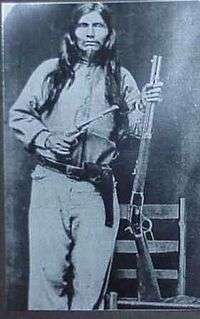Ned Christie
| Ned Christie | |
|---|---|
|
Ned Christie | |
| Born |
NeDe WaDe December 14, 1852 Wauhillau, Oklahoma |
| Died |
November 3, 1892 (aged 39) Wauhillau, Oklahoma |
| Nationality | Cherokee Nation |
| Occupation | Blacksmith, gunsmith |
Ned Christie (December 14, 1852 – November 3, 1892), also known as NeDe WaDe in Cherokee, was a Cherokee statesman. Ned was a member of the executive council in the Cherokee Nation senate, and served as one of three advisers to Chief Bushyhead. He was notable for holding off American lawmen in what was later called Ned Christie's War, after being accused, wrongfully according to testimony in 1918, of murdering a United States Marshal. This gave him notoriety as an outlaw, and he was eventually killed by lawmen.
Early life
Christie was born at Wauhillau (located at 35°51′20″N 94°46′27″W / 35.85550°N 94.77426°W), Going Snake District, Cherokee Nation, in the present-day state of Oklahoma. He was the son of the Removal Era Trail of Tears survivors, Watt and Lydia (Thrower) Christie. They were of the Keetowah band, the most traditional of Cherokee peoples. As a child and young man, Christie was a marble champion, stick ball player and popular fiddle player.
Marriage and family
He was married first to Nannie Dick (about 1871). Next he married Peggy Tucker (1875). Third he married Jennie Scraper (about 1877). Fourth he married Nancy Greece (about 1888).
By religion Ned was a member of the Keetoowah Society. His father, Watt, and grandfather (Lacy Christie), were Chiefs of their ceremonial ground near the family home at Wauhillau (present-day Adair County, Oklahoma).
Work and alleged murder
Christie was a big man at 6 feet 4 inches (1.93 m), and became a blacksmith and gunsmith. In 1885 he was elected to the tribal Senate.[1][2]
In May 1887 U.S. Marshal Daniel Maples was shot and killed in the Cherokee Nation. Christie was accused of the murder by a companion, John Parris, who was at first arrested for the crime. Parris told authorities that Christie had fired the shot that killed Maples. Friends convinced Christie to hide, but he also appealed to the United States Court of the Western District of Arkansas in Fort Smith for bail to allow time to prove his innocence. (This court also had oversight over the Indian Territory.) US Judge Isaac C. Parker did not believe he could comply with the request.[1] Parker's sensational cases and record of executions dominate the period's history, although he also worked to rehabilitate offenders, reform the criminal justice system, and advocate the rights of the Indian nations in the territory.[3]
Fearing a trial before white people in a U.S. court, Christie fortified his home to resist arrest. He began a stand-off with the U.S. that would last almost five years. He was advertised as an outlaw "wanted, dead or alive." In an attack in 1889, lawmen burned his house to the ground, but Christie escaped with friends, although he was wounded by a gunshot. Christie never went to trial.[1]
In 1891 marshals served another warrant for Christie's arrest. He had moved to a more isolated area away from Talhequah, and built a fortified house at Wauhillau. Today it is often referred to as Ned's Fort. The "fort" was a double-log-thick home with sand poured between the logs. He made openings only large enough to see from and put a rifle through.[1]

In 1892, Christie was killed by a posse of lawmen, who attacked his fort with cannon and dynamite.[4] He was shot and killed while running toward the posse. They tied his body to a cellar door for transport by train to Fayetteville, Arkansas. There lawmen had themselves photographed with Christie's body as a trophy of their capturing the "notorious outlaw" who had held off the government for years. Then they transported the body by train to Fort Smith, Arkansas, to gain their reward. Again people had their pictures taken next to Christie's body.[5] The Cook photography studio took a photo to reproduce and sell as postcards. Christie's body was released by authorities to his family, who took it to Wauhillau for burial.[6]
In 1918, a man named Dick Humphreys came forward to authorities and stated he had seen the killing of the marshal Maples. He said that Christie didn't shoot him, but that a man named Bud Trainer did. Christie was cleared at last.[5] Christie's opposition to railroad development in Indian Territory made him many powerful enemies. Some researchers believe that this may have contributed to him being falsely accused of the murder of Maples.[2]
Legacy and honors
Today Christie is honored by a plaque at the Cherokee Court House in Tahlequah, Oklahoma, the oldest public building in the state. The memorial reads that he was "assassinated by U. S. Marshals in 1892." The Fort Smith Historical Site [1] also has material recognizing Christie's assassination.
Many articles about Christie were published in newspapers and western magazines, as his story captured people's imaginations. Christie was also the subject of novels, such as Zeke and Ned by Larry McMurtry and Diana Osana, and Ned Christie's War by Robert Conley. Several non-fiction books have been written, including He Was a Brave Man by Lisa LaRue. Christie's great-great-nephew Roy J. Hamilton wrote a non-fiction account of his life, titled Ned Christie: Cherokee Warrior.
References
- 1 2 3 4 5 "The Case of Ned Christie", Fort Smith Historic Site, National Park Service, accessed 3 Feb 2009
- 1 2 Art T. Burton. "CHRISTIE, NED (1852-1892)". Oklahoma Historical Society. Retrieved 27 February 2011.
- ↑ "Judge Isaac C. Parker", Fort Smith Historic Site, National Park Service, accessed 3 Feb 2009
- ↑ Speer, Bonnie. 1990. The killing of Ned Christie: Cherokee Outlaw. Norman, OK: Reliance Press.
- 1 2 "The Death of Ned Christie", Fort Smith Historic Site, National Park Service, accessed 3 Feb 2009
- ↑ Larry Kraus, "Allen, US Marshal?", 2000-2001,US Ancestry, accessed 2 Feb 2009
